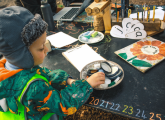Post-Covid, children are struggling with language development and communication when they start school – which causes anxiety and frustration. How can we help them? Sophie Hutton investigates…
We all know what happens if you put a sponge in the bath. It soaks up water until it becomes waterlogged. We also know what happens if you use a sponge to wipe up a small spillage. It soaks up the water, but remains largely dry.
Babies are like bath sponges. Take them out into the world, and they will soak up as much as they possibly can. During Covid, however, the bath became a small spillage.
The children currently in Reception were anywhere between six and 18 months old when the government announced the first lockdown in 2020.
For those vital months when they were acquiring first language skills, the only people who spoke to them were their immediate family. Parents were often harried and exhausted by juggling childcare and working from home.
As a result, 96 per cent of schools have expressed significant concerns over the communication and language development of post-Covid Reception cohorts, according to a 2022 study led by Louise Tracey of the University of York.
And a 2022 report published by the charity Coram Family and Childcare found that Covid left early years children unable to adapt to new situations, socialise and develop self-regulation skills.
Put together, these two findings mean that children unused to dealing with new social situations and lacking the language they need to express their difficulties are finding early years education a bewildering, frustrating and anxiety-inducing experience.
So, what can early years settings do to help?
Arriving in an early years setting as a child with limited communication skills can feel like being parachuted into a foreign country with an unfamiliar culture and a language you don’t understand.
Routines that seem obvious to adults, such as washing hands before snack time or tidying toys away before story time, can feel completely alien – and even threatening – to children.
Visual timetables using symbols are already common in the SEND community. However, they can play a role in mainstream education, too.
A visual timetable uses simple and easily decodable images to show children what is going to happen during the day.
These can include specific activities, such as circle time or outdoor play, or constituent parts of one activity, such as washing hands and then eating a snack.
You can then send these visual timetables home to families, to help children prepare for the day ahead. That way, children know that when they arrive at nursery, there will be circle time and then painting, for example.
This helps to make the day predictable and comprehensible – which reduces children’s anxiety. And any time they feel confused about what’s going on during the day, they can simply glance at the visual timetable and feel reassured.
Adjusting to a new setting is harder for children if they lack the skills to name the emotions they’re experiencing during the process. Unless you know why a child is frustrated or angry, you’re not able to deal with the problem effectively.
It can often be less intimidating for a child to begin by identifying someone else’s emotions. This is why puppets are often popular in early years settings; children find it easier to discuss why a puppet might feel sad than they do to talk about their own sadness.
Another approach is to use familiar characters from stories. Odessa Stephenson, SENCO and early years lead at Monkhouse Primary School, Tyne and Wear, regularly uses storybook characters as a springboard for conversations about emotions.
“We help children to interpret the emotions of others by using story characters,” she says. “For example, we might ask, ‘How did the Billy Goats Gruff feel when the troll said he would gobble them up?’ So when it comes to helping children with their own feelings, they are already developing that emotional literacy.”
And, once children have named the emotion, staff can ask questions such as, “What would make Red Riding Hood feel better?” or “What could Goldilocks have done instead?” This opens up a conversation about how children, too, can manage difficult emotions.
Using story characters to discuss emotions also has the obvious benefit of bringing more stories into the setting. And the more children hear books read to them, the more their own vocabulary will grow.
Any improvement to children’s language development cannot come from the school or nursery alone; it has to involve parents and carers as well.
The Education Endowment Foundation has consistently found that the more engaged parents are in their children’s learning, the better children’s communication, language development and literacy is likely to be.
We often ask parents to use family photos to stimulate conversation at home. A picture of Mummy at her laptop or Daddy washing the dishes will immediately pique a child’s interest.
We then suggest that parents ask simple questions, such as “What is Mummy doing?” or “What is Daddy holding?” This encourages children to construct short sentences about familiar people and everyday activities. It also develops a habit of conversation, which is the bedrock of literacy.
Language development and wellbeing are interlinked. The more we expose children to language and communication, the better they will be able to express themselves – and the more in control of their surroundings they will feel.
And once they’re relaxed in their learning environment, they’ll be free to focus their energy on being sponges once more, soaking up everything they see and hear during the day.
Sophie Hutton is a speech and language therapist, and CEO of Nest Therapy, where she uses Widgit Symbols to help meet children’s speech, language and communication needs. She is also a contributor to the recently published report How to build confident early learners.

Outdoor maths activities – Marvellous muddy maths ideas
Editors picks

ICT in Early Years – The best resources for your setting
Editors picks
